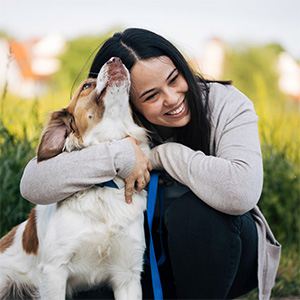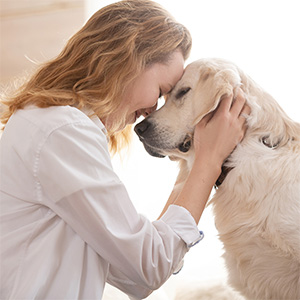
Dogs have a remarkable way of communicating with us, not just through barks and tail wags, but through a rich tapestry of sounds, gestures, and body language. It’s a language that transcends words, and it’s a testament to the deep connection we share with our furry friends.
But did you know that this language goes beyond the obvious cues? In the world of scientific studies, there’s a treasure trove of findings that unravel the astonishing intelligence and emotional sensitivity of dogs. These studies delve into the realms of problem-solving abilities and emotional intelligence, showcasing that dogs can discern when another dog is hurting or when a human is feeling sad, and they respond with empathy. Moreover, these studies reveal fascinating insights about the age equivalence of dogs in relation to humans, with the average adult dog being likened to a human between three to four years old.
So, how can this wealth of knowledge about canine communication help us understand what our beloved pets are trying to convey? It’s a heartwarming journey of discovery that showcases how dogs can understand our body language, adapt their communication to us as humans, and interpret the intricacies of hierarchies and needs within the home.
The Enchanting World of Canine Communication
Our four-legged companions are truly extraordinary beings. They possess a unique ability to decipher not just our actions and words, but also our emotions. Recent studies have uncovered the depths of their cognitive abilities, from solving puzzles to comprehending and responding to emotions—both in their fellow canines and in us, their human companions.
Imagine this scenario: you return home after a long day, brimming with excitement or weighed down by the cares of the world. Your faithful friend greets you at the door, and in an instant, they know whether your heart is soaring or sinking. Their response is a testament to their keen perception of your emotions, tail wagging in exuberance or offering gentle solace. This incredible ability to sense and respond to our emotional states is a testament to the profound connection that dogs share with us.

Let’s delve into how dogs communicate with us:
- Body Language: Dogs are masters of non-verbal communication. They use their body language to convey a wide range of emotions and intentions. Whether it’s the wagging of their tail, the tilt of their head, or the posture of their ears, their body is a canvas for their feelings. By paying close attention to these cues, we can gain precious insights into our dog’s emotional state and needs. If you are interested in a fuller technical viewpoint head to our article here.
- Adapting to Human Communication: Dogs are remarkably adaptable creatures. They recognize that we, as humans, have our own unique ways of communicating. They can adjust their body language and behavior to better connect with us. This adaptability is a testament to the deep bond and understanding that can develop between humans and their canine companions.
- Interpretation of Hierarchies and Needs: Dogs are acutely aware of hierarchies within their social groups, which include your family and home. They can perceive your wants and needs, often before you’re even aware of them yourself. This keen awareness allows them to anticipate your actions and respond in ways that align with your desires.
In essence, dogs are highly attuned to their surroundings and have a keen awareness of what’s happening in your day-to-day life. They can sense your excitement when you return home from work, or the exhaustion that might weigh you down. Their astute observation of your body language informs their responses – whether they’re attempting to engage in play to lift your spirits or simply offering comforting companionship.
A Two-Way Conversation
The key takeaway here is that understanding your dog’s communication is not a one-sided affair. It’s a dialogue, a dynamic exchange between you and your furry companion. You are both actively participating in the development of a shared language, one that transcends spoken words.
This shared language encompasses various elements:
- Body Language: Your dog communicates with you through subtle gestures and postures. Likewise, you communicate with them through your own body language. The way you move, stand, and hold yourself conveys a wealth of information to your dog.
- Verbal Cues: While dogs may not understand every word we say, they do pick up on the tone and cadence of our speech. Your dog can distinguish between a cheerful, playful tone and a somber, soothing one. These verbal cues guide their responses and interactions with you.
- Habits and Routine: Dogs thrive on routine. Your daily habits and activities become a part of their language. They anticipate your actions and respond accordingly. For instance, they may expect a walk at a certain time each day or know when its mealtime based on your routine.

Maintaining a healthy and communicative relationship with your dog is essential for their well-being and your mutual happiness. If you ever find yourself questioning the dynamics of your relationship or suspect that something might be amiss, don’t hesitate to seek guidance.
Professional dog trainers, like those at Paw Commons, can provide invaluable assistance. Our trainers are well-versed in the balance method and are taught a holistic approach to dog training. Additionally, they possess a deep understanding of operant conditioning, a fundamental principle of human psychology. By comprehending the triggers and motivators that influence your dog’s behavior, our trainers can help identify the necessary changes to achieve the outcomes you and your furry friend desire.
In short, the bond between humans and dogs is a beautiful and intricate tapestry of communication. It’s a language that transcends words and is built upon empathy, observation, and love. By embracing this dialogue and nurturing your connection, you and your dog can embark on a lifelong journey filled with understanding, companionship, and unspoken conversations. Your furry friend isn’t just a pet; they’re a cherished member of your family, and their language of love is one worth learning and celebrating.

